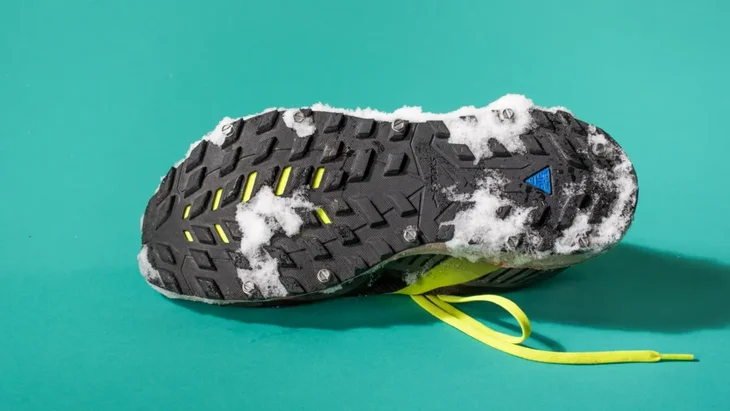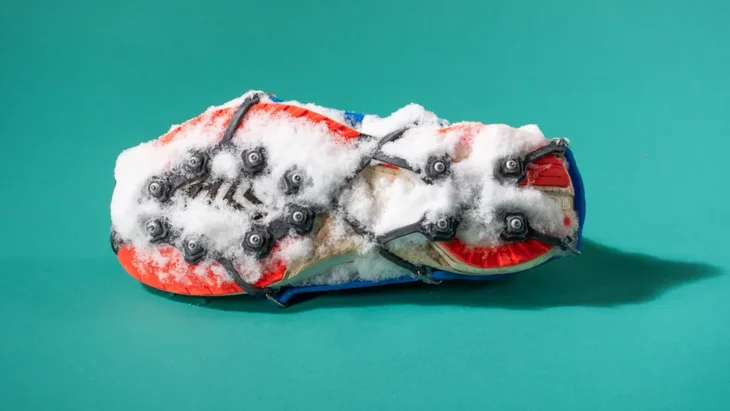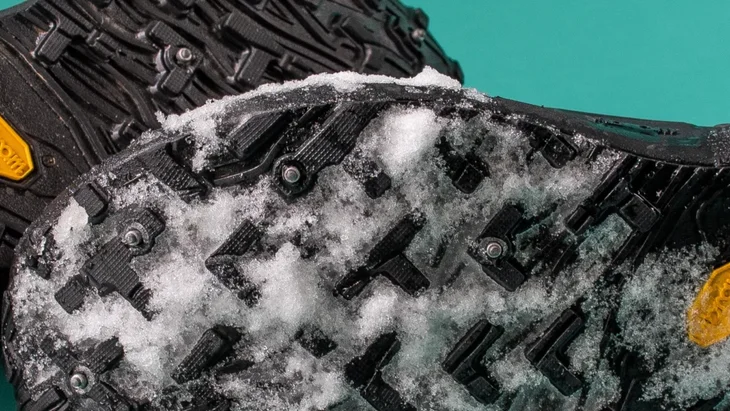New perk! Get after it with local recommendations just for you. Discover nearby events, routes out your door, and hidden gems when you sign up for the Local Running Drop.
If you live in a region where winter conditions—snow, ice, slush—make it tough to run outdoors because of slippery footing, you can invest in enhanced traction so you can keep training consistently. While you can sometimes get by running through snow and slush just by wearing trail running shoes with knobby lugs, there are three ways to improve your running shoes for snowy and icy wintry surfaces, ranging from affordable to relatively expensive.
DIY Running Shoe Spikes for Winter Traction

For about five dollars, you can modify your existing shoes for better traction on ice. An old pair of trainers can get a second life as your winter running shoes simply by inserting metal screws around the perimeter of the outsole to create custom spiked shoes.
How to screw spikes into your running shoes
- Go to your local hardware store or home improvement center and buy a small box of ½-inch #6 hex head sheet metal screws (get at least 8 for each shoe).
- Mark out where you’ll insert the screws around the shoe. It’s best to place them only in the perimeter of the shoe, even though some maximally cushioned shoes have a thick enough midsole that would keep them from poking the bottom of your feet.
- Use a 1/16” diameter drill bit to drill starter holes for the screws, or start the process by pushing a nail or thick pin or needle into the first layer of the outsole.
- Once the screw is started, use a (powered or manual) screwdriver to submerge the screw into the shoe so the flange is flush with the outsole.
For more aggressive traction, consider getting an Ice Spike kit for about $20-$25, or a La Sportiva Hobnails kit for $59.
It’s important to note that none of these DIY options are perfect solutions for everyday winter running, because those screws can fall out or get torn out. But they can usually get you through the season, and that’s all most runners really need. However, if you’re looking for a hardier solution, try getting a pair of dedicated winter running shoes.
RELATED: Our Five Favorite Winter Trail Running Shoes in 2023
Over Spikes for Winter Running

Like snow chains for your car, after-market over spikes pull over your shoes for better grip. Winter running spikes offer improved traction, though they can feel slighty awkward under your feet, especially on harder surfaces. That’s because there is a bit of a disruption of the foot-to-ground proprioceptive connection.
The Yaktrax Pro ($35) is best for running on snowy roads. It provides traction from metal wire coiled around a stretchy elastomer frame that criss-crosses the bottom of the shoe.
Black Diamond’s Distance Spike ($99) is great on snowy roads or trails. The spikes are essentially a running-specific crampon device that includes a series of five aggressive metal claws connected by a small metal chain under the shoe and an elastic rubberized frame that is secured over the top of the shoe.
If deeper snow is on the way, try Kahtoola MICROspikes ($75). Almost identical to the Black Diamond product, the Kahtoola MICROspikes are slightly beefier and heavier. Kahtoola also makes a multi-purpose EXOspikes ($63) and a favorite for hard-packed snow, Kahtoola NANOspikes ($50). The Kahtoolas are the best models we’ve tested, but each is slightly different in its design, so research carefully to identify the best winter running spikes for the conditions you’re facing.
RELATED: Ask a Gear Guru: What Are the Best Accessories for Winter Running?
Winter Running Shoes for Snow and Ice

Dedicated spiked shoes are best for runners who often find themselves on icy and snowy roads, bike paths and trails. They may be overkill for standard trail usage, however. Though they’ll run pretty well on mostly dirt trails, these winter spiked shoes can actually be slippery on trails with a lot of rocks.
There are a few brands that make these specialty winter running shoes, with some of the top models being the Norda 001 G+ Spike ($270), Salomon Spikecross 5 Gore-Tex ($185) and IceBug Pytho6 ($190).
Each of those are rugged trail running shoes that have been enhanced with traction from tiny, carbide tipped metal spikes embedded in the outsole. They’re moderately expensive, but if you’re only running in them 25 to 50 times every winter, they’ll definitely last for many seasons.
RELATED: Best Winter Traction for Trail Runners
Boulder-based Brian Metzler has run more than 75,000 miles in his life, competing in every distance from 50 meters to 100 miles, running the Rim-to-Rim-to-Rim run across the Grand Canyon and back several times, racing pack burros on many occasions and going up Colorado’s Longs Peak 20 times. In 2018, he ran the Great Wall of China, completed the Leadman series and ran a 100K in South Korea. He is the founding editor of Trail Runner and the author of “Kicksology: The Hype, Science, Culture and Cool of Running Shoes.”